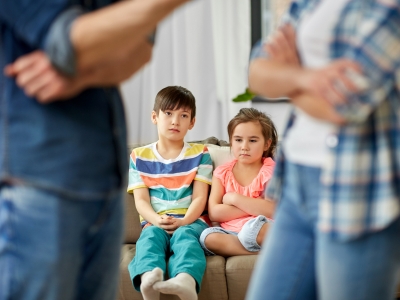
Summer 2025

Household Chaos: How and Why Disruptions at Home Derail Healthy Habits
Chelsea L. Kracht, PhD1; Denver M.Y. Brown, PhD2; Kevin Lanza, PhD3; Eduardo Esteban Bustamante, PhD4; Keith Brazendale, PhD5; Danae Dinkel, PhD6; Rebecca E. Lee, PhD7 - Physical Activity SIG in collaboration with the Child and Family Health SIG
Health behaviors, such as physical activity, are influenced by a multitude of factors, ranging from big-picture policies to individual choices. Most behavior change programs focus on large-scale influences or personal motivations, often overlooking the role of family and home life. This article explores how household chaos—unpredictable routines, noise, and crowding—can affect health behavior and provides future directions for multi-level research and promotion efforts.
What is household chaos?
Household chaos is an established contributing factor to poor child development and increased risk of childhood obesity.1 Unlike individual stressors, it is characterized by disorder, noise, and crowding in the home.2 Disorder refers to the lack of routines or planned sequences of events occurring regularly, and noise is commonly attributable to the TV in the background or to hearing others’ conversations. Crowding is usually represented as more people in the home or living in a smaller space. Household chaos is frequently measured using the 15-item Confusion Hubbub And Order Scale (CHAOS),2 however, there are currently no clinical cut points for unhealthy levels of chaos.
How does household chaos impact health behavior?
Higher levels of household chaos have been linked to a greater risk of poor mental health,1 along with less desirable healthy lifestyle behaviors, including inconsistent sleep routines, excess screen time, and low amounts of physical activity.1,3-6 In general, most literature has focused on parents and young (ages 0-5y) or school-age children (ages 6-12y).1,7
What about other measures of household dynamics?
Another consideration at the household level is family dynamics. Specifically, family problem-solving and family functioning are identified by parenting skills, family relationships, and communication.8,9 These interconnected dynamics underscore the importance of examining household-level factors as potential influences on individual health behaviors, particularly during critical developmental periods.
Future Directions for Research: Expanding existing research into different periods, updating measurement tools, and investigating large-scale solutions may improve our current understanding of household dynamics and their influence on health behavior.
- Longitudinal studies across the perinatal period (pregnancy to child ages 2-y) may answer whether household chaos is a trait or a response to the addition of the child in the home.
- Adapting the existing CHAOS questionnaire to be inclusive and culturally relevant may help address new advances such as cell phones, computers, and remote work. The CHAOS questionnaire was developed over 30 years ago, when landlines were common, TV was the primary source of screen time, and work from home was minimal.2
- Examining household chaos during other transitions, such as summer months, may help untangle the role of routine within the household and its health impact. Less is known about less structured times, such as summer.10
- Prospective studies of local and community policies to support routine and stability may strengthen the evidence. Existing studies document that household space and use, flexible work, childcare options, and income stability are negatively associated with household chaos.6,11
In summary, the home dynamic is a critical component for lifestyle behaviors but is often neglected in current research. Supporting routine and a calm atmosphere in the home may help keep healthy habits on track for the long haul.
Affiliations:
- University of Kansas Medical Center
- Kansas State University
- University of Texas Health Science Center at Houston
- University of Illinois Chicago
- University of Central Florida
- University of Nebraska Omaha
- Arizona State University
References:
- Marsh S, Dobson R, Maddison R. The relationship between household chaos and child, parent, and family outcomes: a systematic scoping review. BMC Public Health. Apr 22 2020;20(1):513. doi:10.1186/s12889-020-08587-8
- Matheny AP, Wachs TD, Ludwig JL, Phillips K. Bringing order out of chaos: Psychometric characteristics of the confusion, hubbub, and order scale. Journal of Applied Developmental Psychology. 1995/07/01/ 1995;16(3):429-444. doi:https://doi.org/10.1016/0193-3973(95)90028-4
- Emond JA, Tantum LK, Gilbert-Diamond D, Kim SJ, Lansigan RK, Neelon SB. Household chaos and screen media use among preschool-aged children: a cross-sectional study. BMC Public Health. Oct 29 2018;18(1):1210. doi:10.1186/s12889-018-6113-2
- Kracht CL, Redman LM, Casey PH, Krukowski RA, Andres A. Association between Home Environment in Infancy and Child Movement Behaviors. Child Obes. Mar 2021;17(2):100-109. doi:10.1089/chi.2020.0319
- Kracht CL, Katzmarzyk PT, Staiano AE. Household chaos, family routines, and young child movement behaviors in the U.S. during the COVID-19 outbreak: a cross-sectional study. BMC Public Health. May 4 2021;21(1):860. doi:10.1186/s12889-021-10909-3
- Kracht CL, Katzmarzyk PT, Staiano AE. Household chaos, maternal stress, and maternal health behaviors in the United States during the COVID-19 outbreak. Womens Health (Lond). Jan-Dec 2021;17:17455065211010655. doi:10.1177/17455065211010655
- Marsh S, Taylor R, Galland B, Gerritsen S, Parag V, Maddison R. Results of the 3 Pillars Study (3PS), a relationship-based programme targeting parent-child interactions, healthy lifestyle behaviours, and the home environment in parents of preschool-aged children: A pilot randomised controlled trial. PLoS One. 2020;15(9):e0238977. doi:10.1371/journal.pone.0238977
- Epstein NB, Baldwin LM, Bishop DS. THE McMASTER FAMILY ASSESSMENT DEVICE. Journal of Marital and Family Therapy. 1983/04/01 1983;9(2):171-180. doi:https://doi.org/10.1111/j.1752-0606.1983.tb01497.x
- Sanders MR, Morawska A, Haslam DM, Filus A, Fletcher R. Parenting and Family Adjustment Scales (PAFAS): Validation of a Brief Parent-Report Measure for Use in Assessment of Parenting Skills and Family Relationships. Child Psychiatry & Human Development. 2014/06/01 2014;45(3):255-272. doi:10.1007/s10578-013-0397-3
- Brazendale K, Beets MW, Weaver RG, et al. Understanding differences between summer vs. school obesogenic behaviors of children: the structured days hypothesis. Int J Behav Nutr Phys Act. 2017;14(1):100. doi:10.1186/s12966-017-0555-2
- Parrish S, Lavis A, Potter C, Ulijaszek S, Nowicka P, Eli K. How active can pre-schoolers be at home? Parents' and grandparents' perceptions of children's day-to-day activity, with implications for physical activity policy. Social Science & Medicine. 2021/11/06/ 2021:114557. doi:https://doi.org/10.1016/j.socscimed.2021.114557